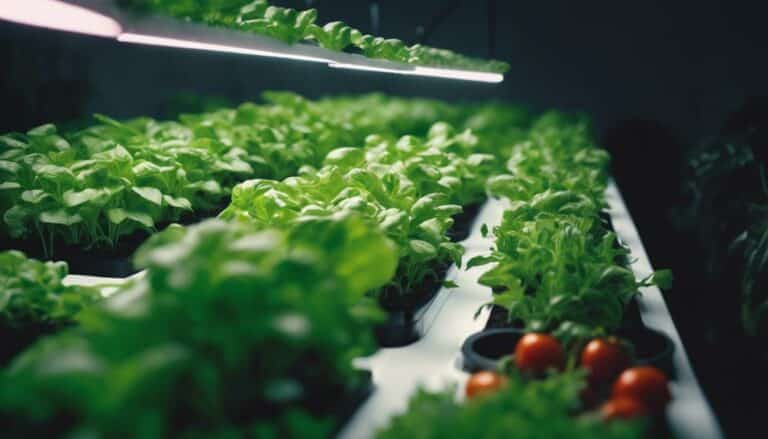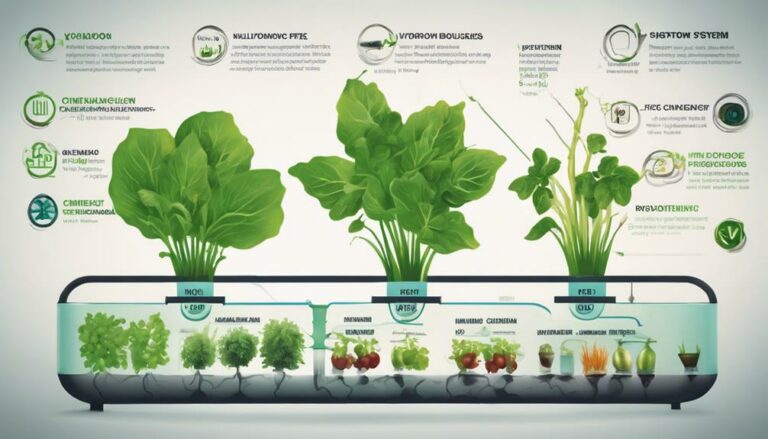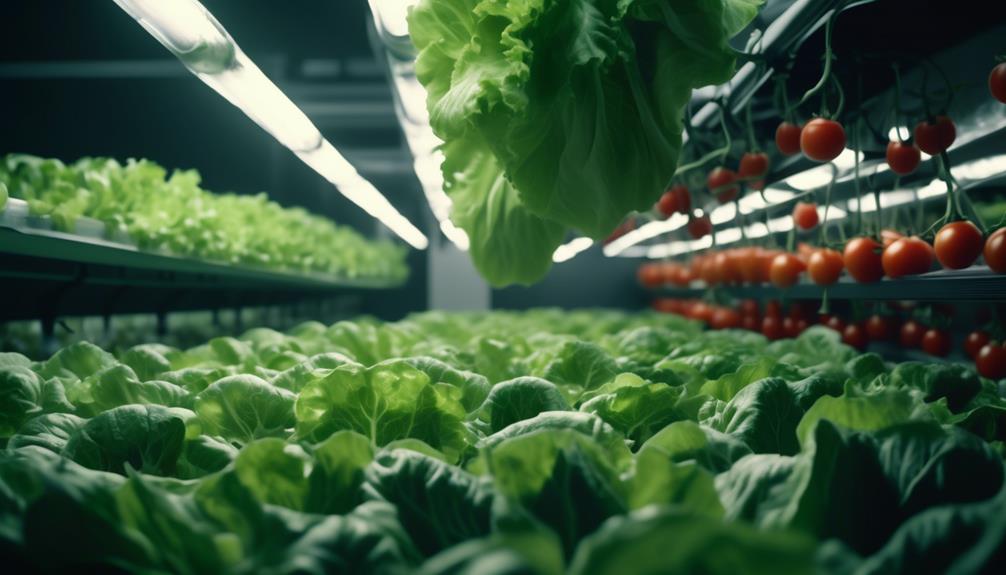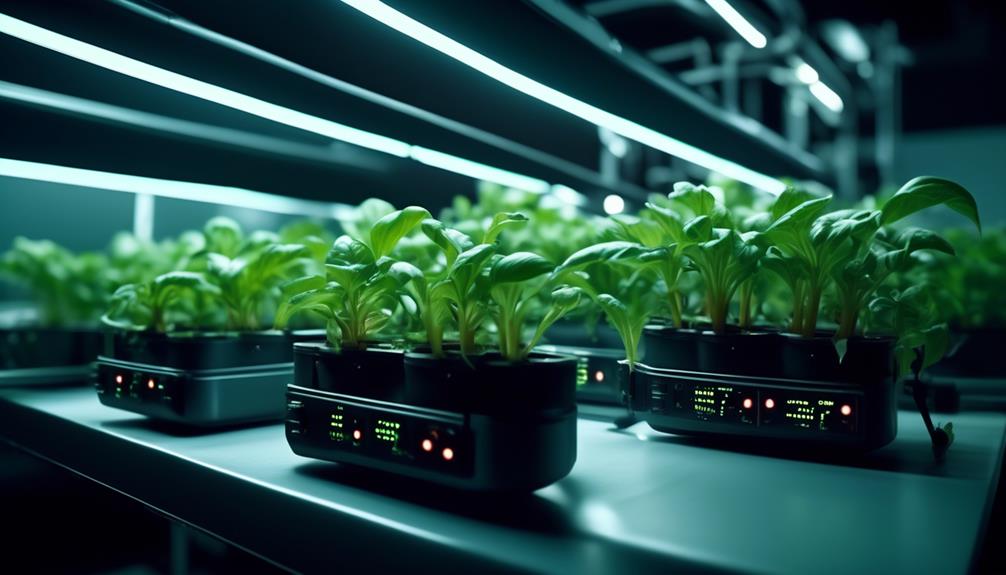Table of Contents
Maintaining a hydroponic system in tip-top shape requires a blend of the right tools and a sprinkle of dedication. Start by preparing your workspace and gathering essential supplies like rubber gloves, sponges, and your choice of a cleaning solution—white vinegar or mild dish soap. Remove all plants and debris to guarantee a clear cleaning path. Drain the system, meticulously scrub away algae and mineral deposits, and don’t forget to disinfect with your chosen solution. Smaller components need some love too—soak and scrub them individually. A final flush guarantees a hygienic environment ready for your plants. Now, isn’t it exciting to think about the efficiency a clean hydroponic system brings to your plant’s growth? Let’s embark on this journey together for healthier plants!
Key Takeaways
- Empty the system, removing all nutrient solution and organic debris to prepare for cleaning.
- Use a mild dish soap or white vinegar solution to scrub the system, focusing on areas with algae or mineral buildup.
- Disassemble and soak smaller components in a diluted hydrogen peroxide solution, then thoroughly scrub and rinse them.
- After scrubbing, rinse the system with clean water, then apply a vinegar and water mix to disinfect and prevent future growth of pathogens.
- Dry all parts completely before reassembling the system to prevent mold and bacterial growth, ensuring a hygienic environment for plants.
Preparing Your Workspace
Before commencing the task of cleaning your hydroponic system, why not start by meticulously preparing your workspace, ensuring it is devoid of extraneous plants and fully equipped with the necessary tools and cleaning agents? This initial step is essential for fostering an environment conducive to innovation and efficiency. By removing other plants from the grow room, you concentrate your efforts on the hydroponic system, minimizing distractions and potential cross-contamination.
Having a clear workspace allows for the strategic placement of cleaning tools such as rubber gloves, sponges, and scrubbers. These tools are essential for tackling the task at hand, from scrubbing away stubborn organic matter to ensuring every nook and cranny of your hydroponic setup is sanitized. A prepared workspace also implies having cleaning solutions like hydrogen peroxide or vinegar within reach. These are invaluable for soaking smaller components, ensuring a thorough clean that’s critical for the efficient functioning of your system.
Starting with a well-organized and equipped workspace not only streamlines the cleaning process but also sets the stage for a successful cultivation period ahead. This approach underscores the importance of preparation, ensuring that your hydroponic system operates at its best.
Gathering Essential Supplies
Before beginning the cleaning journey of your hydroponic system, assembling the right arsenal of cleaning supplies is essential. Choices in cleaning solutions range from mild dish soap, known for its gentle yet effective cleaning prowess, to white vinegar, which doubles as a natural disinfectant.
Equally important are the tools for the task, including luffa sponges for a soft touch on delicate surfaces and a nylon bristle scrub brush for those stubborn stains, ensuring your system is not just clean, but hygienically welcoming for your plants.
Cleaning Solution Choices
Selecting the right cleaning solution, either mild dish soap or white vinegar, is essential for effectively removing residue and disinfecting a hydroponic system. When it comes to ensuring your hydroponic system operates at its peak, the choice of cleaning agent plays a pivotal role.
White vinegar, a natural disinfectant, offers an eco-friendly solution capable of annihilating bacteria and fungi, safeguarding your plants’ health. On the other hand, mild dish soap emerges as a gentle yet effective contender, boasting an ease of rinsing that prevents any harmful residue.
For those prioritizing innovation and efficiency, considering a spray bottle for applying your chosen cleaning solution could streamline the process, blending convenience with effectiveness in maintaining your hydroponic system’s pristine condition.
Necessary Cleaning Tools
Having outlined the importance of choosing the right cleaning solution, it is equally important to gather the appropriate tools for an effective cleaning process of your hydroponic system. Essential tools include rubber gloves, to keep your hands safe; face masks, for protection against any splashes; and sponges and scrubbers, for those hard-to-reach places.
Don’t forget the bottle brushes, clean cloths, and buckets, critical for an all-around clean. A reliable water source is, of course, indispensable. Small plastic bins come in handy for soaking smaller components.
With food-grade hydrogen peroxide or vinegar as your go-to solutions, you’re set for a safe and thorough clean hydroponic system. Remember, proper dilution and avoiding chemical mix-ups are key to avoiding any system damage.
Removing Plants and Debris
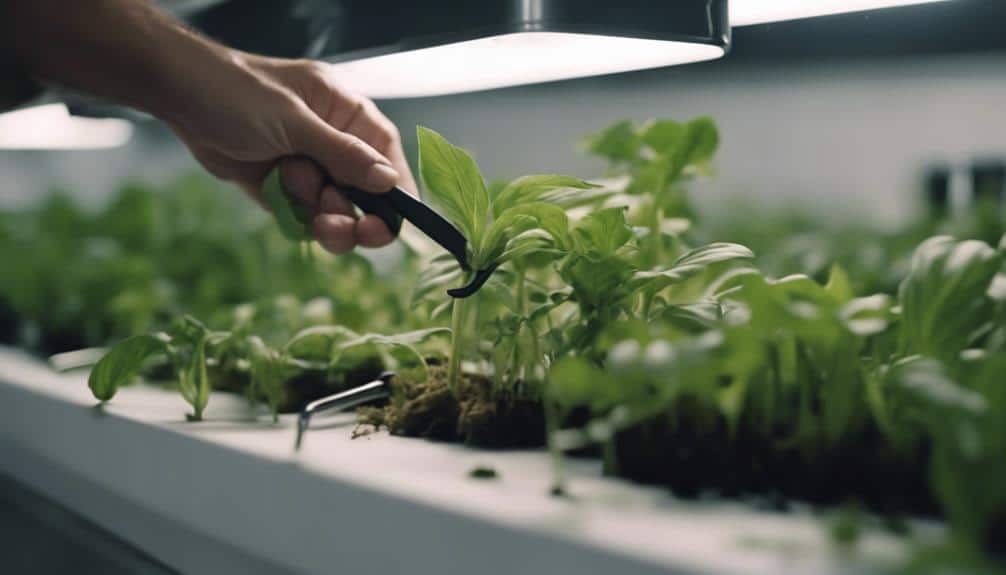
As we move on to the important steps of removing plants and debris from your hydroponic system, it’s essential to grasp effective plant removal techniques and debris clearing methods.
This stage is crucial for ensuring that the system is free from obstructions and ready for a thorough cleaning and sanitization.
Plant Removal Techniques
Before initiating the cleaning process of a hydroponic system, it is crucial to carefully remove healthy plants to protect them from potential damage. When cleaning your hydroponic system, consider the following steps to guarantee a smooth plant removal:
- Gently extract healthy plants, making sure to support their roots and foliage to avoid stress.
- Dispose of dead or diseased plants immediately to prevent the spread of pathogens within your clean system.
- Inspect the roots of each plant for signs of disease or pests, ensuring a healthy restart.
- Remove all plant debris and organic matter, creating a clear path for an effective cleaning process.
These steps not only safeguard your plants but also set the stage for a successful maintenance routine.
Debris Clearing Methods
To effectively clear debris from your hydroponic system, begin by meticulously removing all plants, ensuring both living and dead organic matter is eliminated. This initial step is important for innovators in hydroponic cultivation, as it sets the stage for a pristine environment conducive to growth.
Next, diligently dispose of any organic matter or debris that may obstruct the system’s efficiency. Dead or diseased plants should be removed promptly to prevent contamination, an essential action for maintaining a healthy hydroponic ecosystem. Thorough inspection for hidden debris or plant residues is imperative, as overlooked fragments can compromise the system’s functionality.
Conclude this phase by ensuring the system is completely empty, setting the perfect stage for a fresh water flush, symbolizing a fresh start and the promise of innovation in hydroponic farming.
Draining the System
Draining the hydroponic system, which involves the removal of the nutrient solution, is a vital step in preparing for a thorough cleaning process. This pivotal action sets the stage for an effective cleanse, aiming to maintain peak plant health and system efficiency. The process is not just about eliminating the visible; it dives deeper to guarantee a pristine environment for your plants to thrive.
To make this task more approachable and make sure nothing is overlooked, consider the following steps:
- Drain the Remaining: Begin by emptying the basin of its contents, focusing on removing the bulk of the nutrient solution.
- Use a sponge or a wet-and-dry vacuum to meticulously clear out any residual liquid that could harbor unwanted guests like pests or fungi.
- Pay extra attention to removing any shallow solution layers that might be clinging to the sides of your system.
- Ensure that all organic matter, dead plants, pests, and fungi are thoroughly removed during this process.
Initial Scrubbing Techniques
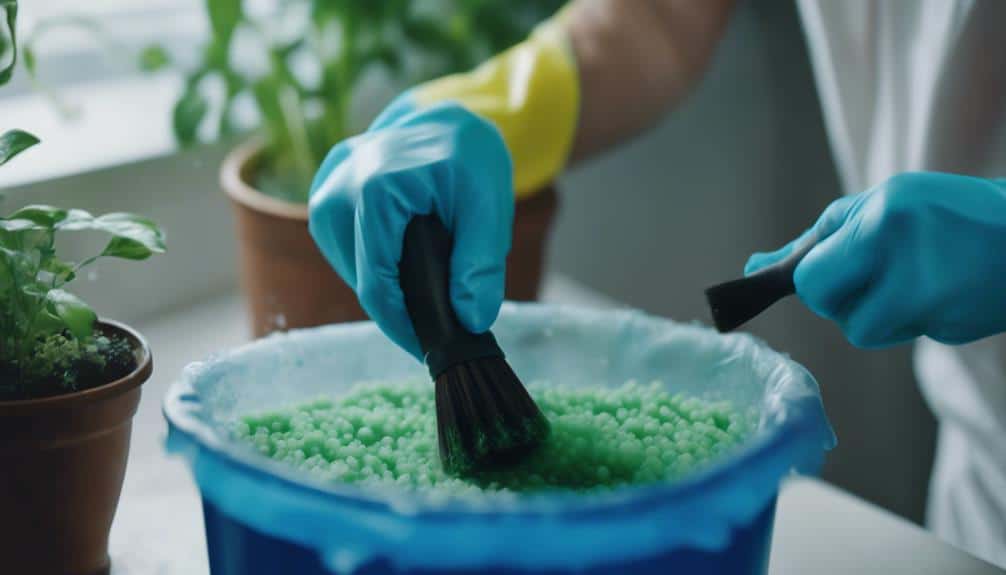
Following the draining of the hydroponic system, the next vital step involves employing initial scrubbing techniques to guarantee all components are free from algae, mineral deposits, and organic build-up. This phase is essential for maintaining a clean and efficient hydroponic setup.
Using a nylon bristle scrub brush is highly recommended for this task. Its gentle yet effective bristles ensure that you can scrub all surfaces thoroughly without causing any damage. Whether it’s persistent algae clinging to the sides or stubborn mineral deposits that seem to have made a permanent home on your system, the right brush can make all the difference.
It’s essential to focus particularly on areas prone to organic matter accumulation, such as around the roots and on the tubing. These spots can become hotbeds for blockages if not addressed properly. Additionally, ensuring your scrub brush reaches into every nook and cranny guarantees that no area is left uncleaned. This meticulous approach not only helps in preventing clogs and blockages but also ensures that your plants receive the right nutrients without any deficiencies.
Regular scrubbing as part of your “Clean Your Hydroponic” routine is more than just a chore; it’s a ticket to a flourishing hydroponic system.
Disinfecting With Vinegar
After the initial scrubbing phase, incorporating vinegar as a disinfectant offers an effective and eco-friendly method to further guarantee the cleanliness of your hydroponic system. Utilizing vinegar not only embraces a safer approach but also assures that your system remains free from harmful bacteria, fungi, and algae that could jeopardize the health of your plants.
For those desiring innovation in maintaining a pristine hydroponic environment, vinegar stands out as a stellar choice for several reasons:
- Eco-Friendly Solution: Vinegar is a safe, natural alternative to chemical cleaners, reducing environmental impact.
- Effective Disinfectant: It kills a wide range of pathogens, helping to safeguard plant roots against diseases.
- Easy to Prepare and Use: A simple mixture of vinegar and water can be used to thoroughly clean and sanitize system components.
- Regular Maintenance: Incorporating vinegar into your cleaning regimen helps maintain a healthy hydroponic environment over time.
Cleaning Smaller Components
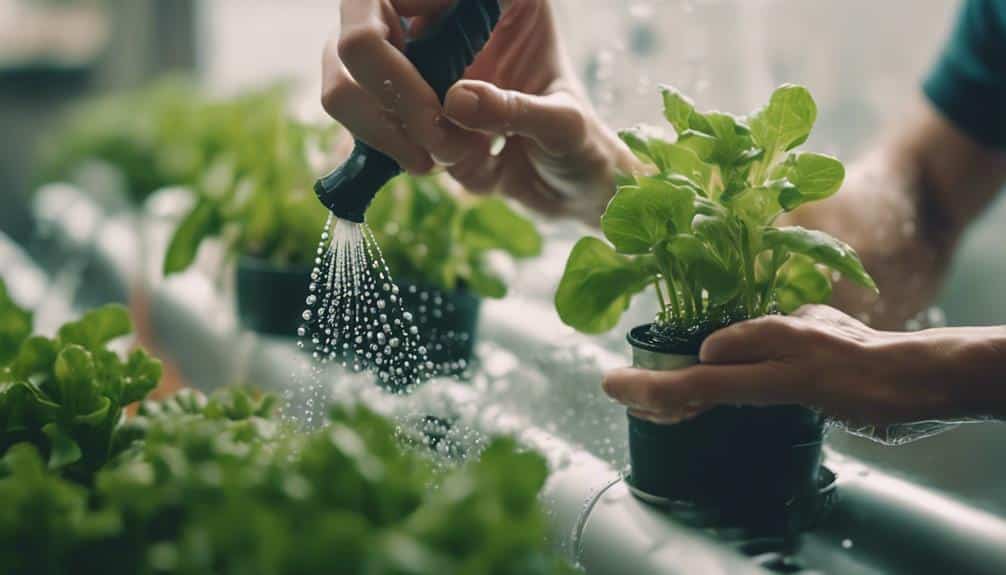
Having discussed the benefits of vinegar as a disinfectant, attention must now turn to the meticulous cleaning of smaller hydroponic system components. These diminutive parts, often overlooked, are critical to the seamless operation of your hydroponic garden. To access these smaller components, it’s important to disassemble your system, revealing the net pots, air stones, and tubing that lie within.
For those innovators among us keen on maintaining a pristine environment for our plants, the next step involves a soak in the magic potion: diluted hydrogen peroxide. This solution not only sings a swan song for pathogens but does so with the gentle touch needed for these smaller, sometimes delicate parts. Mix hydrogen peroxide with water and let the components marinate, making sure every nook and cranny is free from unwanted guests.
After a thorough scrubbing that would make even the most meticulous among us proud, it’s vital to dry off each piece before reassembly. This final step ensures that your system isn’t just clean but also primed for peak performance. Remember, a clean hydroponic system is a happy one, ready to nurture your plants back to their green glory.
Conducting a Cleansing Cycle
Moving on to the heart of our hydroponic system’s rejuvenation, conducting a cleansing cycle is essential for maintaining a healthy environment for your plants.
Choosing the right cleansing agents, setting up the cycle correctly, and keenly monitoring the process to make necessary adjustments guarantees your system operates at its best.
This phase not only dictates the cleanliness of your setup but also greatly impacts the overall success of your hydroponic endeavors.
Choosing Appropriate Cleansing Agents
Selecting the right cleansing agent is crucial for conducting an effective cleansing cycle in a hydroponic system, ensuring both the elimination of pathogens and the safety of plants. To achieve this, it’s essential to:
- Use hydrogen peroxide for its dual benefits of killing pathogens and being plant-safe.
- Consider diluted bleach, ensuring it’s thoroughly rinsed to safeguard plant health.
- Opt for vinegar as a natural, plant-friendly option with antimicrobial properties.
- Always prioritize agents that efficiently remove all organic material while being benign to plants and the environment.
Choosing an appropriate cleansing agent is a cornerstone in maintaining a flourishing hydroponic garden, marrying efficiency with environmental consciousness.
Setting Up Cleansing Cycle
Initiating a cleansing cycle in your hydroponic system begins with the removal of the nutrient solution and any present organic materials from the tank. This step is crucial to guaranteeing your plants grow in an environment that’s as clean as it can be.
| Step | Purpose | Benefit for Plants |
|---|---|---|
| Drain & Remove | Eliminates old nutrients and debris | Prevents disease and stress |
| Clean & Disinfect | Removes harmful microbes and build-up | Ensures healthy growth |
| Dry Components | Prevents water buildup and contamination | Reduces risk of root rot |
| Regular Cycle Setup | Maintains system efficiency | Promotes ideal nutrient uptake |
Adhering to these steps not only fosters a thriving environment for your hydroponic garden but also ensures the longevity of your system, making the journey of watching your plants grow even more rewarding.
Monitoring and Adjusting Process
Once the cleansing cycle is underway, diligent monitoring of the hydroponic system is essential to guarantee its components function at their best and the environment remains conducive to plant health. For those who treasure their grow room, here’s how to keep it in top shape:
- Closely watch system components during cleaning to make sure they operate at their best.
- Tailor the cleaning cycle to your plants’ and system’s unique needs for peak growth.
- Document changes in plant health or growth post-cleaning to measure success.
- Adjust the routine as necessary to combat algae, bacteria, or other pesky invaders.
Flushing Out the System
To effectively cleanse a hydroponic system, the first essential step involves draining the nutrient solution entirely. This vital action paves the way for a thorough cleaning process, guaranteeing that every inch of the system is free from any lingering nutrient build-up.
The next phase involves engaging with a mild soap solution, meticulously scrubbing the tank to remove any residue that might harbor potential pathogens or contaminants. This step is not just about making the system look clean; it’s about ensuring it’s a safe environment for your next cycle of plants.
Once scrubbing has ensured the physical removal of build-up, it’s time to turn our attention to disinfection. A vinegar and water mix comes into play here, acting as a gentle yet effective agent against harmful pathogens that could compromise plant health.
It’s imperative not to overlook the smaller components of the system during this cleaning phase. These nooks and crannies can be hotspots for contaminants if left unchecked.
Drying and Reassembling
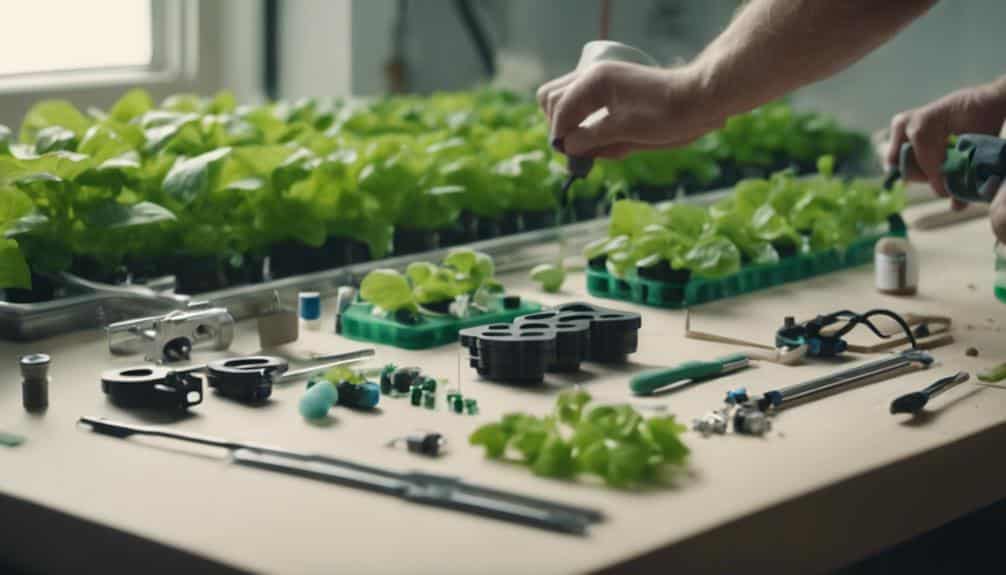
After the thorough cleaning process, why is it important to make sure that each component of the hydroponic system is completely dry before reassembly? Ensuring all parts are bone-dry is critical in warding off any mold or bacterial growth that could compromise the health of your plants and the efficiency of your system. Remember, every gallon of water should be accounted for, not just in your system but in the drying process too.
- Use clean towels: They’re your best friends in absorbing every last drop of moisture from the reservoir, tubing, and grow trays.
- Prevent waterborne pathogens: Proper drying is your shield against unseen enemies that thrive in damp conditions.
- Maintain ideal conditions: A dry system is a happy home for your plants, ensuring they get the nutrients they need without the risk of contamination.
- Accurate reassembly: This guarantees your system runs smoothly, ensuring every gallon of water delivers life, not problems, to your plants.
Frequently Asked Questions
What Can I Use to Clean a Hydroponic System?
To maintain an innovative hydroponic system, consider using hydrogen peroxide or white vinegar as cleaning agents. These food-grade solutions effectively eliminate pathogens, algae, and mineral build-up, ensuring a healthy environment for plant growth.
How Often Should You Clean a Hydroponic System?
To guarantee plant health and system efficiency, the cleaning frequency for a hydroponic system should ideally be every 1-2 weeks. This regular maintenance prevents nutrient imbalances and inhibits harmful microbial growth.
Can I Use Vinegar to Clean Hydroponics?
Vinegar, recognized for its efficiency and antimicrobial properties, serves as an eco-friendly and cost-effective solution for cleaning hydroponic systems. Diluting it properly guarantees the safety of both plants and equipment during the cleaning process.
How Do You Flush a Hydroponic System?
Flushing a hydroponic system involves employing specific techniques to remove excess salts and prevent nutrient imbalances, ensuring ideal plant growth. This process requires draining the old solution, then introducing fresh, pH-balanced water to maintain system health.
Conclusion
In summary, maintaining a clean hydroponic system is essential for the best growth of plants and the overall efficiency of the system. Regular cleaning not only prevents the buildup of harmful pathogens and algae but also guarantees the components function effectively.
By following the outlined steps, one can ensure their hydroponic system remains in prime condition, fostering a healthy environment for plant growth. This routine care, while seemingly meticulous, pays dividends in the longevity and productivity of the hydroponic garden.








